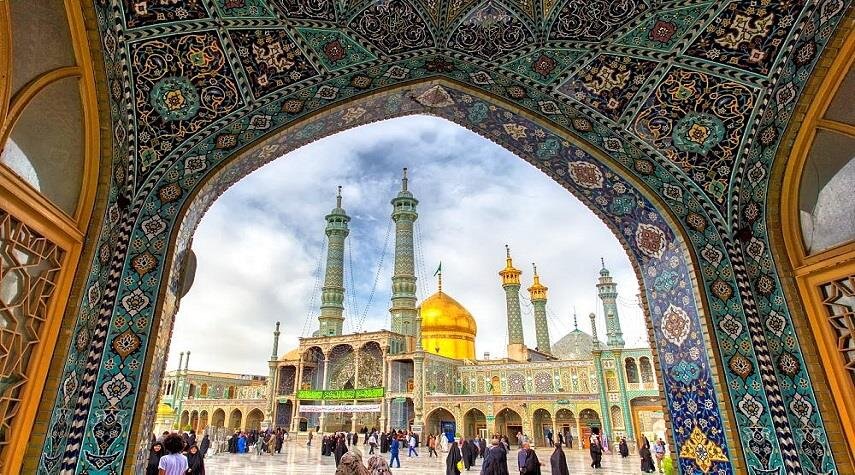Qom, a prime destination for pilgrims, day-trippers, history buffs, and nature lovers

Iran’s second holiest city after Mashhad, Qom is home to the holy shrine of Hazrat-e Masumeh (SA), several major seminaries, madrasas as well as many tourism resorts both cultural and natural.
Visitors to Qom can be classified into two groups of people; sightseers, day-trippers, and pilgrims, who want to pay homage to the holy shrine, and Shiite scholars and students who come from across the world to learn Islamic studies and browse through eminent religious bookshops.
Qom, which its antiquity goes back to the Sassanid era (224 CE–651), has many must-see destinations such as historical mosques, mansions, and natural sceneries scattered across the city as well as towns and villages nearby.
If as a travel lover you are tired of quarantine over the coronavirus outbreak and are counting down the days to start your travels again, Qom could be a good warm-up as the first post-corona destination:
Old Bazaar of Qom
The Old Bazaar of Qom is one of the most beautiful historical bazaars in the country in terms of architecture. The bazaar consists of different sections and two rows covered with domes, which help the proper ventilation and lighting. Due to the desert climate, the city of Qom has very hot summers and very cold winters, which is also the reason why the bazaar is covered to stay safe from this extreme heat and cold.
The complex has been made of clay, mud, brick, and stone. The different parts of the bazaar have been built in different historical eras such as the Seljuk, Ilkhanid, Safavid, and Qajar eras. In the early Pahlavi period (1925-1979) new sections were added to the historical structure.
The beautiful and exemplary architecture of the bazaar and its old and pleasant atmosphere always attract many tourists.
Haj Asgar Khan Public Bathhouse
Located near the holy shrine of Hazrat-e Masumeh (SA) and north of the bazaar, Haj Asgar Khan Public Bathhouse was built in the early Qajar era (1789–1925). The complex consists of three sections, which are covered by brick domes.
With the amendments made for the heating and lighting systems, the bathhouse is still operational and is used by the locals, however, women are not allowed to enter.
Deir-e Gachin Caravanserai
Deir-e Gachin Caravanserai is one of the greatest caravanserais of Iran, which is located in the center of Kavir National Park, 80 kilometers to Qom.
Considered as the “Mother of Iranian Caravanserais” due to its unique features and antiquity, the caravanserai was built during the Sassanid era (224 CE–651), which means it is more than 1750 years old.
The caravanserai, which was once of the most prosperous roadside inns across the country, was renovated and restored during the Seljuk and Safavid eras, and new sections were added to it during the Qajar period.
The name Deir-e Gachin (literally meaning “cloister of plaster”) comes from the fact that gigantic loads of plaster were used for its construction.
Qomrud Castle
In the old village of Qomrud, near Qom, there are remnants of an ancient castle that dates from the Parthian era (247 BC – 224 CE). Unfortunately, there are not many relics of this building left, but still, it is worth a visit.
Zand Mansion
One of the most beautiful historical buildings in the city, Zand Mansion was built during the Qajar era as the personal residence of Haj Ali Khan Zand, one of the city’s elites.
Stained glass windows and doors, a beautiful big yard and fountains, and a small pool in the middle, which cool the air, can be seen in the building.
The Anthropological Museum of Qom is also located within the mansion.
Collection of historical mosques
As a religious city and a center for Islamic studies, Qom is full of mosques and holy shrines, most of which with historical values and were built in the Qajar era.
Aqa Mosque and School, Atiq Mosque, Azam Mosque, Jameh Mosque of Qom, and holy shrines of Imamzadeh Hamzeh and Imamzadeh Ahmad ibn Qasem are located in the old neighborhoods of the city and are renovated and restored.
Kahak
As the city has a hot and desert climate, the surrounding villages are most visited during the warmer months of the year.
Kahak, for its moderate and pleasant climate, is very popular among the Qom citizens during the summer.
The village was also home to the philosopher Mulla Sadra, also called Sadr-ol-Mote’allehin (born c. 1571, Shiraz, Iran—died 1640, Basra, Iraq). His home is one of the main attractions of the village.
Hoz Soltan Salt Lake
One of the most visited natural spots of Qom is Hoz Soltan Salt Lake also known as Namak Lake. The beautiful lake is in the middle of the desert and several rivers, passing through different salt marshes, flow into it.
Located to the north of Qom, the lake has created one of the most beautiful sceneries in the desert. The visitors could easily walk in the shallow parts and enjoy the shapes created by the salt, however, the center of the lake could be dangerous, as it is muddy and could easily trap people.
ABU/AFM
Leave a Comment